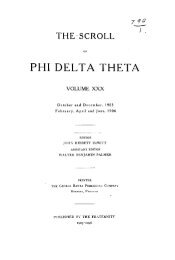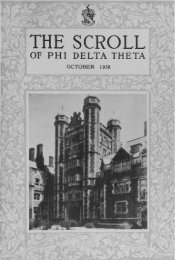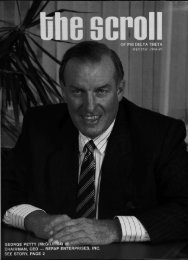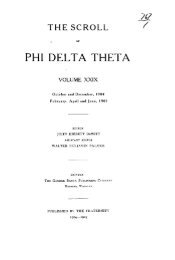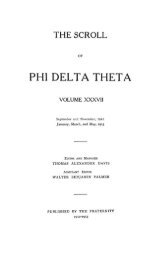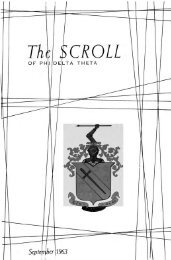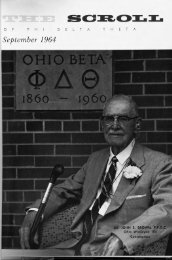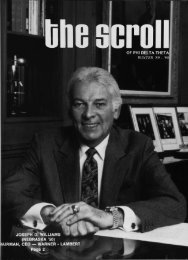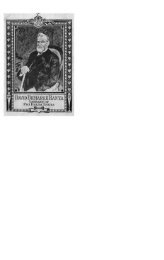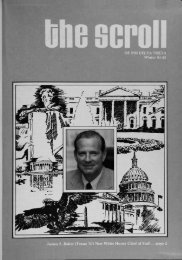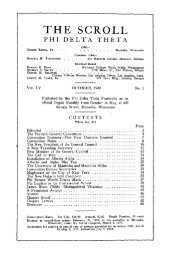- Page 1 and 2:
Ol:THE SCROLLic?PHI DELTA THETAVOLU
- Page 3:
LNDEX 3Watch-fob, designed by Walte
- Page 7 and 8:
THE SCROLL.— • • - « —Vol.
- Page 9 and 10:
HON. JOHN W. FOSTER, INDIANA, '55.F
- Page 11 and 12:
THE SCROLL. 5Century of American Di
- Page 13 and 14:
THE SCROLL. 7once, on leaving the 1
- Page 15 and 16:
HON. JAMES CI,ARK:E MCRBYNOLDS, VAN
- Page 17 and 18:
HON. JOHN T. MORRISON, WOOSTER. '87
- Page 19 and 20:
IHE SCROLL. 13and in 1834 represent
- Page 21 and 22:
Courtesy of the Churchman.THE REVER
- Page 23 and 24:
THE SCROLL. 17ALSTON ELLIS, PH. D.,
- Page 25 and 26:
DR. AI^TON EtUS, MIAMI, '67.Preside
- Page 27 and 28:
THE SCROLL. 31unusual success and p
- Page 30 and 31:
24 THE SCROLL.articles of incorpora
- Page 32 and 33:
26 THE SCROLL.football squad, rowed
- Page 34:
28 THE SCROLL.Slater, '94; Nathanie
- Page 37 and 38:
THE SCROLL. 31developmental period
- Page 39 and 40:
THE SCROLL. 33demonstrated their wo
- Page 41 and 42:
Stmi"So, «w''^^I^^^^'WHBH^^HwiM|-.
- Page 43 and 44:
l ^ 1 .i.m.M ...Courtesy of Funk &
- Page 46 and 47:
40 THE SCROLL.columns with stylobat
- Page 48 and 49:
42 THE SCROLL.The members of the ch
- Page 50 and 51:
44 THE SCROLL.They want to communic
- Page 52 and 53:
46 THE SCROLL.And we firmly believe
- Page 54 and 55:
48 THE SCROLL.Several changes have
- Page 56 and 57:
50 THE SCROLL.Bro. Gray,'03, who is
- Page 58 and 59:
52 THE SCROLL.A. Rowe, Amsterdam, N
- Page 60 and 61:
54 THE SCROLL.the Laureate Boat Clu
- Page 62 and 63:
56 THE SCROLL.ing medicine at the H
- Page 64 and 65:
58 THE SCROLL.college year in the g
- Page 66 and 67:
6o THE SCROLL.In athletics Lehigh a
- Page 68 and 69:
62 THE SCROLL.follows :*Ae, 5; SAE,
- Page 70 and 71:
64 THE SCROLL.founding Tennessee Al
- Page 72 and 73:
66 THE SCROLL.Bro. Richardson has b
- Page 74 and 75:
68 THE SCROLL.ALABAMA BETA, ALABAMA
- Page 76 and 77:
70 THE SCROLL.week. The toast-maste
- Page 78 and 79:
72 THE SCROLL.man bid. We hope the
- Page 80 and 81:
74 THE SCROLL.we have been rushing,
- Page 82 and 83:
76 THE SCROLL.INDIANA GAMMA, BUTLER
- Page 84 and 85:
78 THE SCRO'LL.INDIANA ZETA, DE PAU
- Page 86 and 87:
8o THE SCROLL..we also have the ple
- Page 88 and 89:
S3 THE SCROLL.We wish to extend to
- Page 90 and 91:
84 THE SCROLL.Claire, Wis., and Bro
- Page 92 and 93:
S6THE SCROLL.representative; he is
- Page 94 and 95:
88 THE SCROLL.The football outlook
- Page 96 and 97:
90 THE SCROLL.School has now been r
- Page 98 and 99:
92 THE SCROLL.hundred dollars' wort
- Page 100 and 101:
94 THE SCROLL.PERSONAL.Allegheny—
- Page 102 and 103:
96 THE SCROLL.Sewanee—Rev. C. B.
- Page 104 and 105:
98 THE SCROLL.California—Samuel B
- Page 106 and 107:
loo THE SCROLL.Chicago is starting
- Page 108 and 109:
I02 THE SCROLL.and it was while liv
- Page 110 and 111:
I04 THE SCROLL.The trustees of the
- Page 112 and 113:
io6 THE SCROLL.not often lead his c
- Page 114 and 115:
io8 THE SCROLL.K A has been granted
- Page 116 and 117:
no . THE SCROLL.Delta Theta, howeve
- Page 118:
112 THE SCROLL.1903. Requests for s
- Page 122 and 123:
ii6 THE SCROLL.The official program
- Page 124 and 125:
ii8 THE SCROLL.to have more of the
- Page 126 and 127:
I20 THE SCROLL.Letters appear in th
- Page 129 and 130:
THE SCROLL.— K —Vol. XXVffl. DE
- Page 131 and 132:
SYRACUSE UNIVERSITY—LYMAN C. SMIT
- Page 133 and 134:
IHESCROLL.SYRACUSE UNIVERSITY—VON
- Page 135 and 136:
THE SCROLL. 127financial aid. Anoth
- Page 137 and 138:
THE SCROLL. 129from the rear entran
- Page 139 and 140:
THE SCROLL. 131lished here in 1873
- Page 141 and 142:
THE SCROLL. 133The Jayhawker of Kan
- Page 143 and 144:
THE SCROLL. 135freshman president,
- Page 145 and 146:
THE SCROLL. 137the book is of high
- Page 147 and 148:
-is
- Page 149 and 150:
THE SCROLL. 141men do not do their
- Page 151 and 152:
THE SCROLL. 143inence in college af
- Page 153 and 154:
THE SCROLL. 145letter societies as
- Page 155 and 156:
THE SCROLL. 147fight their battles
- Page 157 and 158:
THE SCROLL. 149lists of all organiz
- Page 159 and 160:
m^\ >#'^^jfS|b^m^^/•^jf's''•""i
- Page 161 and 162:
• < ^ . "HQgs- ^:PW'^' • tD=*Ni
- Page 163 and 164:
THE SCROLL. 155wit: 2 'varsity capt
- Page 165 and 166:
Han
- Page 167 and 168:
THE SCROLL. 159of the faculty to th
- Page 170 and 171:
ALPHA PROVINCE CONVENTION.
- Page 172 and 173:
i62 THE SCROLL.stage was banked wit
- Page 174 and 175:
i64 THE SCROLL.cago, Bro. Curtis ha
- Page 176 and 177:
i66 THE SCROLL.today. Exactly what
- Page 178 and 179:
i68 THE SCROLL.heartily to wish for
- Page 180 and 181:
I70 THE SCROLL.The system itself is
- Page 182 and 183:
172 THE SCROLL.house'at college sho
- Page 184 and 185:
1/4 THE SCROLL.men, which is ample
- Page 186 and 187:
176 THE SCROLL.the control of the s
- Page 188 and 189:
178 THE SCROLL.course. The fact tha
- Page 190 and 191:
i8o THE SCROLL.Chapter Corresponden
- Page 192 and 193:
i83 THE SCROLL.initiated are as fol
- Page 194 and 195:
iS4 THE SCROLL.the season. Bros. Wi
- Page 196 and 197:
186 THE SCROLL.ported a thoroughly
- Page 198 and 199:
188 THE SCROLL.PENNSYLVANIA EPSILON
- Page 200 and 201:
I90 THE SCROLL.undet way, and Bros.
- Page 202 and 203:
192 THE SCROLL.Watson, in Richmond,
- Page 204 and 205:
194 THE SCROLL.of the freshman clas
- Page 206 and 207:
196 THE SCROLL.GEORGIA BETA, E^IORY
- Page 208 and 209:
198 THE SCROLL.OHIO BETA, OHIO WESL
- Page 210 and 211:
200 THE SCROLL.done at the Central
- Page 212 and 213:
203 THE SCROLL.Of last year's men,
- Page 214 and 215:
204 THE SCROLL.blighted by the deat
- Page 216 and 217:
2o6 THE SCROLL.ellyn Williams, Jr.,
- Page 218 and 219:
2o8 THE SCROLL.Knox has also had th
- Page 220 and 221:
2IO THE SCROLL.university basketbal
- Page 222 and 223:
212 THE SCROLL.York University, for
- Page 224 and 225:
214 THE SCROLL.One of the newest th
- Page 226 and 227:
2i6 THE SCROLL.TEXAS GAMMA, SOUTHWE
- Page 228 and 229:
2i8 THE SCROLL.Bros. Chamberlain an
- Page 230 and 231:
220 THE SCROLL.Miami—'The Future
- Page 232 and 233:
222 THE SCROLL.Iowa Wesleyan—John
- Page 234 and 235:
224 THE SCROLL.Indianapolis—John
- Page 236 and 237:
226 THE SCROLL.Michigan will endeav
- Page 238 and 239:
228 THE SCROLL.The athletic associa
- Page 240 and 241:
230 THE SCROLL.A Z A, originating a
- Page 242 and 243:
232 THE SCROLL.Phi Gamma Delta has
- Page 244 and 245:
234 THE SCROLL.Council and editor o
- Page 246 and 247:
236 THE SCROLL.The first badge made
- Page 248:
238 THE SCROLL.dresses. Bro. Drummo
- Page 253:
THB SCROLL. 241ried through, and th
- Page 256 and 257:
244 THE SCROLL.large fire-place sim
- Page 258 and 259:
246 THB SCROLL.caused great excitem
- Page 260 and 261:
248 THE SCROLL.The annual published
- Page 262 and 263:
2 50 THE SCROLL.This settled the fi
- Page 264 and 265:
252 THE SCROLL.became a member of I
- Page 266 and 267:
254 THE SCROLL.burg in 1902. Its au
- Page 268 and 269:
256 THE SCROLL.this privilege was g
- Page 270 and 271:
258 THE SCROLL.contains only 556 na
- Page 272 and 273:
2 6o THE SCROLL.but one who will no
- Page 274 and 275:
262 THE SCROLL.City in November. Br
- Page 276 and 277:
264 THE SCROLL.Emerson, supposed to
- Page 278 and 279:
266 THB SCROLL.Winston, he won the
- Page 280 and 281:
268 THE SCROLL.Dr. JohnC. Morgan of
- Page 282 and 283:
2 70 THE SCROLL.and prestige of the
- Page 284 and 285:
2 72 THE SCROLL.functions of the va
- Page 286 and 287:
2 74 THE SCROLL.which will bring us
- Page 288 and 289:
2 76 THE SCROLL.Maine Alpha has rec
- Page 290 and 291:
278 THB SCROLL.should still be kept
- Page 292 and 293:
2 8o THE SCROLL.The musical associa
- Page 294 and 295:
282 THE SCROLL.new pledges this ter
- Page 296 and 297:
284 THE SCROLL.A week or two ago, a
- Page 298 and 299:
286 THE SCROLL.TENNESSEE ALPHA, VAN
- Page 300 and 301:
288 THE SCROLL.ahead of the institu
- Page 302 and 303: 2 90 THE SCROLL.and manufacturers i
- Page 304 and 305: 292 THE SCROLL.Since our last lette
- Page 306 and 307: 2 94 THE SCROLL.title to the univer
- Page 308 and 309: 296 THE SCROLL.ILLINOIS DELTA, KNOX
- Page 310 and 311: 2q8 THE SCROLL.year a concert tour
- Page 312 and 313: 300 THE SCROLL.has to take the init
- Page 314 and 315: 302 THE SCROLL.Legislature at the p
- Page 316 and 317: 304 THE SCROLL.THETA PROVINCE,WASHI
- Page 318 and 319: 3o6 THE SCROLL.Randolph-Macon—Rev
- Page 320 and 321: 3o8 THE SCROLL.Ohio—H. G.. Armstr
- Page 322 and 323: 3IO THB SCROLL.The one hundredth an
- Page 324 and 325: 312 THE SCROLL.of one man from each
- Page 326 and 327: 314 THE SCROLL.Referring to this ma
- Page 328 and 329: 3i6 THE SCROLL.According to a new r
- Page 330 and 331: 3i8 THE SCROLL.It has just come to
- Page 332 and 333: 320 THE SCROLL.Within a short time
- Page 334 and 335: 322 THB SCROLL.fraternities have al
- Page 337: THE SCROLL. 325THE PYX,Reporters of
- Page 341 and 342: THE SCROLL. 329There appears to be
- Page 343 and 344: THESCROLL.We should begin to consid
- Page 347 and 348: THE SCROLL,Vol, XXVIII, APRIL, 1904
- Page 349 and 350: THE SCROLL. 333and weak institution
- Page 351: THE SCROLL. 335and entertain their
- Page 355: THE SCROLL. 339tagonism between Gre
- Page 359 and 360: THE SCROLL. 343country combined and
- Page 361 and 362: THE SCROLL. 345Saturday. The reason
- Page 363 and 364: THE SCROLL. 347Lombard fellows take
- Page 365 and 366: THE SCROLL. 349Chicago; don't know
- Page 367 and 368: THE SCROLL. 351that body had unanim
- Page 369 and 370: THE SCROLL. 353The Executive Commit
- Page 371 and 372: THE SCROLL. 355I have written to Br
- Page 373 and 374: THB SCROLL. 357for two Indiana Delt
- Page 375 and 376: THE SCROLL. 359G. M. Bulla will be
- Page 377 and 378: THE SCROLL. 361members of the facul
- Page 379 and 380: THE SCROLL. 363of any man in Nebras
- Page 381 and 382: THE SCROLL. 365buy his way into the
- Page 383 and 384: THE SCROLL. 367chapters and 26 alum
- Page 385 and 386: THE SCROLL. 369With three chapters,
- Page 387 and 388: THE SCROLL. 371A Trident, the A T A
- Page 389 and 390: THB SCROLL. 373have done." Concerni
- Page 391 and 392: THE SCROLL. 375EDITORIAL,THE frater
- Page 393 and 394: THB SCROLL. 377and standing of the
- Page 395 and 396: THE SCROLL. 379Chapter Corresponden
- Page 397 and 398: THE SCROLL. 381MASSACHUSETTS ALPHA.
- Page 399 and 400: THE SCROLL. 383NEW YORK DELTA, COLU
- Page 401 and 402: THE SCROLL. 385The basketball team
- Page 403 and 404:
THE SCROLL. 387Hoffman, '02, and Cl
- Page 405 and 406:
THE SCROLL. 389Recently we have had
- Page 407 and 408:
THE SCROLL. 391with Mr. Heissman as
- Page 409 and 410:
THE SCROLL. 393assured. It is the d
- Page 411 and 412:
IHE SCROLL. 395EPSILON PROVINCE,IND
- Page 413 and 414:
THE SCROLL. 397on May 4, at which t
- Page 415 and 416:
THE SCROLL. 399Interf rater nity ba
- Page 417 and 418:
THE SCROLL. 401of each of the other
- Page 419 and 420:
THE SCROLL. 403not give the usual M
- Page 421 and 422:
THE SCROLL. 405success and will pro
- Page 423 and 424:
THE SCROLL. 407Baseball practice ha
- Page 425 and 426:
THE SCROLL. 409E. A. Garretson, Cal
- Page 427 and 428:
THE SCROLL. 411Lincoln, '97. Ohio S
- Page 429 and 430:
THE SCROLL. 413alumni, stating our
- Page 431 and 432:
THE SCROLL. 415Dyer, Lawrence, '59;
- Page 433 and 434:
THE SCROLL. 417mention to be held a
- Page 435 and 436:
THB SCROLL. 419profitably spent. Af
- Page 437 and 438:
THE SCROLL. 421Before the banquet,
- Page 439 and 440:
THE SCROLL. 423poetical?" Aufwieder
- Page 441 and 442:
THB SCROLL. 425PERSONAL,Nebraska—
- Page 443 and 444:
THE SCROLL. 427Ohio Wesleyan—Dr.
- Page 445 and 446:
THE SCROLL. 429van were lost, and i
- Page 447 and 448:
THE SCROLL. 431saved. Managing Edit
- Page 449 and 450:
THE SCROLL. 433Dr. Andrew S. Draper
- Page 451 and 452:
THB SCROLL. •'435p. 0,0,0,ft -rt
- Page 453 and 454:
THE SCROLL. 437alleged "founder." I
- Page 455 and 456:
THE SCROLL. 439E. D. Warfield told
- Page 457 and 458:
THE SCROLL. 441The Tulane correspon
- Page 459 and 460:
THE SCROTAL. 443The following is cl
- Page 461 and 462:
THE SCROLL. 445Dr. H. C. Tolman, pr
- Page 463 and 464:
THE SCROLL. 447first annual pig bar
- Page 465 and 466:
IHE SCROLL. 449membership are: Virg
- Page 467 and 468:
THE SCROLL. 451did house and two va
- Page 469 and 470:
THB SCROLL. 453proposes a little ha
- Page 471 and 472:
THB SCROLL. 455which, will be treas
- Page 473 and 474:
THB SCROLL. 457B. M. L-. Ernst, cor
- Page 475 and 476:
THE SCROLL. 459It gives us all sinc
- Page 477 and 478:
THE SCROLL. 461that fraternity. * A
- Page 479 and 480:
THB SCROLL. 463That college undergr
- Page 481 and 482:
THE SCROLL. 465President Elliot of
- Page 485:
THE SCROLL,Vol. XX JUNE, 1904 No, 5
- Page 489 and 490:
THB SCROLL. 471Mrs. Charles M. Schw
- Page 491 and 492:
PENNSYLVANIA STATE COLLEGE—CAMPUS
- Page 493 and 494:
PENNSYLVANIA STATE COLLEGE—^BUII.
- Page 495:
THE SCROLL. 477orchestra and two dr
- Page 499 and 500:
THE SCROLL. 481In March a new prosp
- Page 502:
484 THE SCROLL.the lake, are the un
- Page 506 and 507:
488 THE SCROLL.fifty per cent of th
- Page 508 and 509:
49 o THE SCROLL.and numerous *B K k
- Page 510 and 511:
"'W0^' -l^?^-J* ^ # ^WmS^m^^^^^m^^-
- Page 512 and 513:
494 THE SCROLL.THE PHIS OF MORRISVI
- Page 514 and 515:
496 THB SCROLL.his section, and his
- Page 516 and 517:
498 THE SCROLL.Grand Chief Templar
- Page 518 and 519:
500 THE SCROLL.Robert Homer Gaines,
- Page 520 and 521:
502 THE SCROLL.Edward Cool Robertso
- Page 522 and 523:
S04 THE SCROLL.that brought them in
- Page 524 and 525:
5o6 THE SCROLL.a time the change ap
- Page 526 and 527:
5o8THB SCROLL.west. He was engaged
- Page 528 and 529:
51°THESCROLL.church at Annandale,
- Page 530 and 531:
512 THB SCROLL.taneously in such ci
- Page 532 and 533:
514 THE SCROLL.WILLIAM M. ROBENOLT,
- Page 534 and 535:
5i6 THE SCROLL.with the manufacture
- Page 536 and 537:
Si8 THE SCROLL.his activities,—le
- Page 538 and 539:
520 THE SCROLL.Though in his youth
- Page 540 and 541:
522 THE SCROLL.KOBERT ABRAHAM DAVIS
- Page 542 and 543:
524 THE SCROLL.EDITORIAL,"THE old o
- Page 544 and 545:
526 THE SCROLL.much they have cheri
- Page 546 and 547:
528 THE SCROLL.Chapter Corresponden
- Page 548 and 549:
53° THE SCROLL.Alpha will lose fou
- Page 550 and 551:
5^2 THE SCROLL.NEW YORK ALPHA, CORN
- Page 552 and 553:
534 THE SCROLL.work for his team. H
- Page 554 and 555:
536 THE SCROLL.f he chapter h^ been
- Page 556 and 557:
538 THE SCROLL.inhabitants of the d
- Page 558 and 559:
540 THE SCROLL.has placed him at th
- Page 560 and 561:
542 THE SCROLL.'A large and brillia
- Page 562 and 563:
^44 THk SCRt^LL.OHIO THETA, UNIVERS
- Page 564 and 565:
546 THE SCROLL.The new engineering
- Page 566 and 567:
548 THE SCROLL.ZETA PROVINCE.^ILLIN
- Page 568 and 569:
S50 THE SCROLL.this respect and has
- Page 570 and 571:
552 THE SCROLL.hard this spring, bu
- Page 572 and 573:
554 THE SCROLL.movement and we shal
- Page 574 and 575:
556 THE SCROLL.wouldn't be the same
- Page 576 and 577:
558 THE SCROLL.The post-prandial ex
- Page 578 and 579:
S6o THE SCROLL.PERSONAL,Knox—J. S
- Page 580 and 581:
562 THE SCROLL.Vanderbilt—W, S. F
- Page 582 and 583:
§64 THE SCROLL.12, 1904, in St. Pa
- Page 584 and 585:
566 THE SCROLL.Tenth district, T. W
- Page 586 and 587:
568 THE SCROLL.to the department of
- Page 588 and 589:
570 THE SCROLL.head of their respec
- Page 590 and 591:
572 THE SCROLL.The K 2 Caduceus ior
- Page 592 and 593:
S74 THE SCROLL.For various reasons,
- Page 594 and 595:
576 THE SCROLL.as may tend to lead
- Page 596 and 597:
578 THE SCROLL.K S revived a chapte
- Page 598 and 599:
-PLAK or c-UD>;ifii 'Ftaink. J\ti^.
- Page 600 and 601:
f 582THE SCROLL.The convention reso
- Page 602 and 603:
584 THE SCROLL.As a fraternity man
- Page 604 and 605:
586 THE SCROLL.vention of that prov
- Page 606 and 607:
588 THE SCROLL.years has been at 56
- Page 608 and 609:
590 THE SCROLL.Thomas Mitchell Leml
- Page 610 and 611:
592 THE SCROLL.SUMMER ADDRESSES,A l
- Page 612 and 613:
594 THE SCROLL.agement were also sp
- Page 614 and 615:
596 THE SCROLL.For particulars in r
- Page 616 and 617:
598 THE SCROLL.CONVENTION CITY CHAN
- Page 618 and 619:
2 THE HISTORY OF PHI DELTA THETA.Th
- Page 620 and 621:
4 THE HISTORY OF PHI DELTA THETA.No
- Page 622 and 623:
6 THE HISTORY OF PHI DELTA THETA.em
- Page 624 and 625:
ANCIENT PHI BETA KAPPA SILVER MEDAL
- Page 626 and 627:
IOTHE HISTORY OF PHI DELTA THETA.et
- Page 628 and 629:
SIGMA ALHHA EPSILON.Ai^PHA-T^f OMEG
- Page 630 and 631:
Nc Sir.MA Nu.Whether K .V had or no
- Page 632 and 633:
16 THE HISTORY OF PHI DELT.'^ THETA
- Page 634 and 635:
Michigan Alpha—University of Mich
- Page 636 and 637:
GEORGE BANTAPUBLISHINGCO.iBfiitml H
- Page 638 and 639:
DIRECTORYPHI DEI^TA THETA FRATERNIT
- Page 640 and 641:
Iowa Alpha—Iowa Wesleyan Universi
- Page 642 and 643:
NATIONAL CONVENTION.ATLANTA, GA., N
- Page 644 and 645:
Louisville, Ky.—Peyton B. Bethel,
- Page 646:
PROF-ESSIONA UOONXIDIRECTORY,NEW YO



